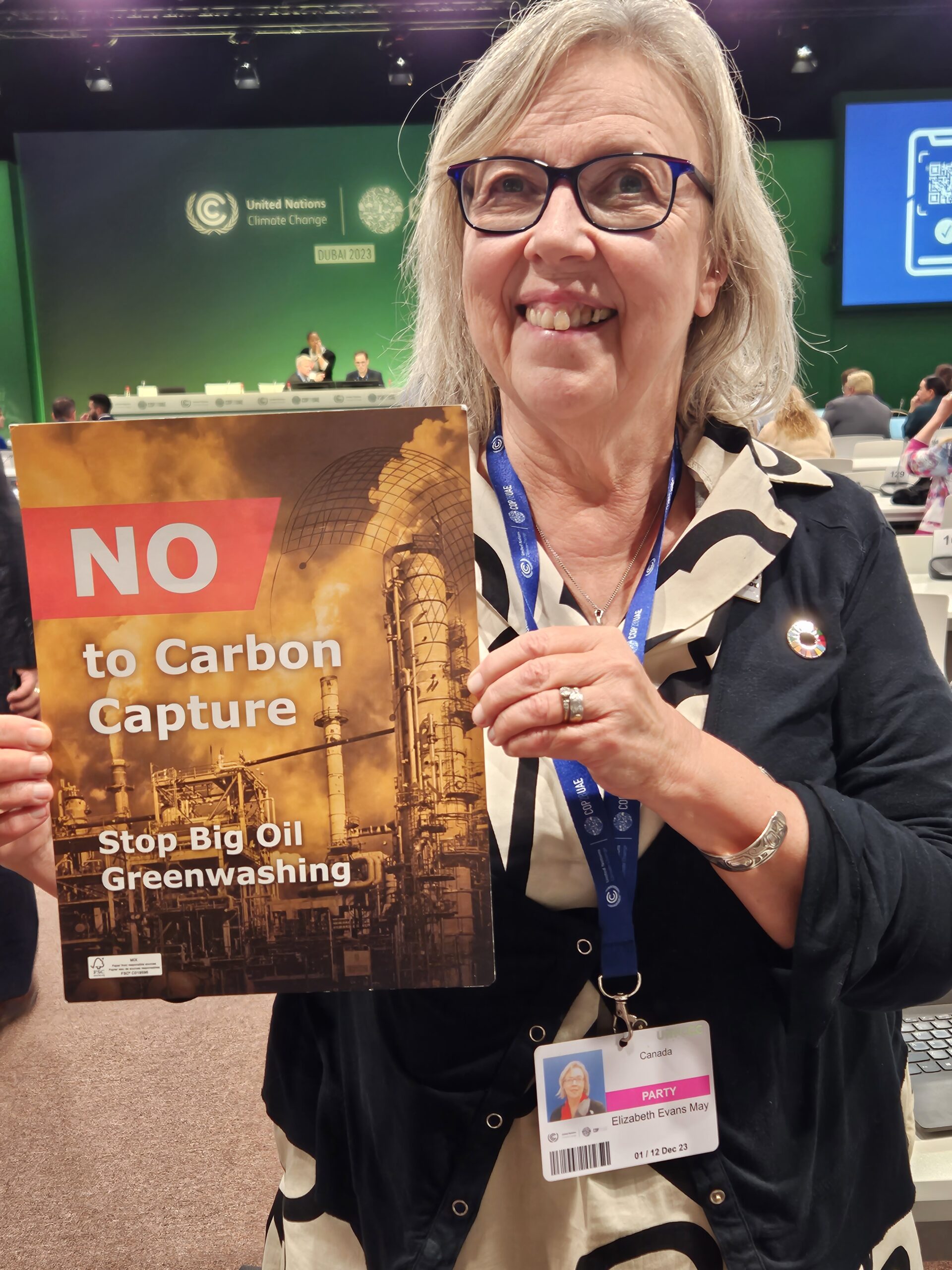Letter From COPO28: Who’s Winning?

Elizabeth may at COP28 in Dubai/John Kidder
By Elizabeth May
December 9, 2023
As we begin the second week of negotiations here in Dubai, it is fair to ask “how is it going?” Which puts me in mind of a conversation I once had with my late British father-in-law after he’d spent a full day at the Derby county cricket match.
“Who won?” I asked, unfamiliar with the sometimes drawn-out nature of the game the late, great Robin Williams dubbed baseball on Valium.
“Not over yet,” he replied. “The match continues tomorrow.”
“Well, who’s winning?” I asked.
“Too soon to tell.”
And, so it goes with every COP.
At mid-point in this quite controversial COP28 Dubai, who is winning?
First, score a few points for the fossil fuel lobby. Canada’s cap on emissions has been announced. It is a framework to develop a cap that will start having effect by 2026 and has a goal of reducing emissions by 2030, but by less than previous promises, and carefully designed to allow an increase in production.
In good news for the climate, Canada and many other nations have committed to serious action to reduce methane emissions. Canada also announced a $31 million replenishment of the Montreal Protocol fund to continue to drive down emissions of both ozone depleting and warming gases under the Kigali amendment to the Protocol. As announced early in this COP, we also have positive news in commitments to the new Loss and Damage Fund, now up to $700 million.
So far, the biggest win on the climate side of the ledger so far is the pledge to triple investments in renewable energy and double energy efficiency by 2030 – now endorsed by 125 nations, including Canada. The EU has put maximum pressure on China to sign on. We will see.
Meanwhile, Canada has been more energetically shilling for the nuclear industry, one of 22 countries pledging to invest and build nuclear reactors, to triple by 2030.
As I run into parliamentarians from other countries, there is a level of disbelief in the idea that anyone would build new nuclear reactors. While the federal Liberals and a number of provincial governments seem to have fallen for the idea that there is something new and magical about Small Modular Reactors (SMRs) with very little skepticism from the Canadian media, the reality is far different. The recent World Nuclear Industry Status Report 2023 — not a report hostile to the industry — concluded:
“Small Modular Reactors, by virtue of the fact that they are designed to generate less electricity than standard reactor designs, will necessarily face greater economic challenges. When compared to large reactors, SMRs will be more expensive per unit of installed capacity and produce more costly power. The trend of SMR designers to move towards larger design outputs — South Korea moving from a 100 MW design to a 170 MW design, Rolls-Royce proposing a 470 MW design — offers evidence for the continued importance of economies of scale. However, even after increasing output power, SMRs remain uneconomical. The case of NuScale, with a cost estimate of around US$20,000 per kW of installed capacity, illustrates how expensive SMRs could be. All SMR designs are being developed with large amounts of public money. The puzzle remains why governments continue to invest in a suite of technologies that appear doomed to commercial failure.”
So far, the biggest win on the climate side of the ledger is the pledge to triple investments in renewable energy and double energy efficiency by 2030 – now endorsed by 125 nations, including Canada.
In fact, shortly after this report was issued the planned NuScale SMR to be built in Utah, the furthest along in approvals in the United States, was cancelled.
“The termination of NuScale’s contract signals the broader challenges of developing nuclear energy in the United States,” said Edwin Lyman, director of nuclear power safety at the Union of Concerned Scientists. “Placing excessive reliance on untested technologies without adequate consideration of economic viability, practicality, and safety concerns is irresponsible and clearly won’t work.”
The German MPs, both Greens and more Conservative, whom I have met here in Dubai, are very pleased with unexpectedly good results in removing all nuclear-generated electricity from their grid. It has reduced electricity costs and boosted renewables. “The steep climb in electricity generation from solar and wind sources,” per Reuters last April, “up 19.5% and 10% respectively in 2022 — helped lift Germany’s total electricity generation by 0.2% last year, despite a 50% drop in nuclear output due to earlier reactor shutdowns, and an 11% fall in hydropower output due to drought.”
As one German MP explained it to me, nuclear is so inflexible, you cannot crank it up or down, so it acts as a block for accessible and available renewables. Wind power had to be kept off grid to leave the space nuclear electricity needed.
As negotiations continue for the final text of the “Global Stock-taking”, nuclear lobbyists hope to get a call for increased nuclear energy in the text. Meanwhile, with more than 125 countries now signed up for tripling renewable energy and doubling energy efficiency, that language is in current drafts.
We are now down to “crunch time” and negotiations will start pushing into the round-the-clock sessions that COPs have become famous for. The president of this COP, as all presidents do, says we will end on time, December 12.
For now, the debates and arm-twisting continue, but mostly in hallways and closed rooms, with the usual negotiation truism applying that nothing is settled until everything is settled. In addition, of course, to that other truism from the great Yankees batsman: “It ain’t over ‘till it’s over.”
Contributing Writer Elizabeth May, MP for Saanich-Gulf Islands, is the Leader of the Green Party of Canada.
